Termites are destructive. They specifically feed on wooden parts of building structures.
These include furniture that is made of wood. If a termite infestation is not handled as soon as it is noticed, it can cause massive destruction of property.
They can munch on wooden roofing and put the occupants of the building at risk. What makes this even worse is that some species of termites destroy the wooden structures unnoticed.
So, Can A Manufactured Home Get Termites?
A manufactured home is vulnerable to termite attacks. There are two major classes of termites: Subterranean and Drywood termites. Subterranean termites can enter the house through the rooftop. This indicates that even a new manufactured home is vulnerable to attack. In this guide, we walk you through all the facts you need to know about termites infestation, how to prevent and destroy them, and much more.
What Does A Termite Look Like?
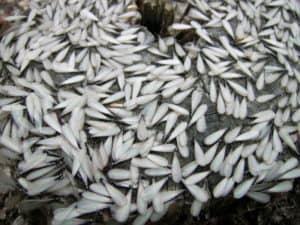
There are numerous small organisms on earth. As such, some homeowners may find it very difficult to tell what a termite looks like.
Well, a termite is a tiny, plump, white ant.
Termites are typically 7 to 8 inches long.
Their size should not make you take them for granted. They can cause massive damage to your home especially the wooded parts of the building. Termites work like machines; they are real beasts!
Termites are much smaller than household ants. Perhaps this is why many people see household ants and think they have seen termites.
Swarming ants have a tight waist between segments which termites do not have. This can be the best way to distinguish between the two.
You should also note that it may prove very rare to see a termite even in a massive infestation.
They like hiding to avoid direct exposure to dry open air. You always have to open the infested wood and observe them.
Do Carpenter Ants Indicate The Presence Of Termites?
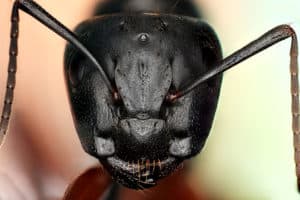
Many homeowners confuse Carpenter ants with termites. The truth is that the two have no relationship and the presence of the other does not indicate the possibility of having the other in your home.
On the contrary, carpenter ants are natural enemies of termites. They are known to raid termites and kill them.
To distinguish between the two, it is important to note that carpenter ants are twice larger as termites.
Zoologists do not consider carpenter ants as a wood-destroying organism.
But they bore into wooden furniture to create nests for themselves. If you find both carpenter ants and termites in your manufactured home, perhaps it is a coincidence.
Honestly, the two have no relations. They do not have a notable symbiotic relationship and the other does not attract the presence of the other.
Do Termites Get Into Concrete Blocks?
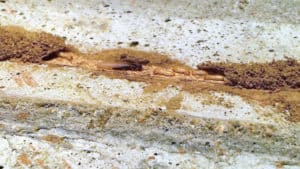
As we had mentioned earlier, termites are tiny, ferocious organisms that can even get to concrete blocks.
Termites can infest a blockhouse from the bottom or the top. It depends on the species.
Subterranean termites get into the concrete block from the bottom. They spend some time in the soil before finding their way to the house to locate and consume wooden parts. They will then get back to their nest in the ground.
Subterranean termites
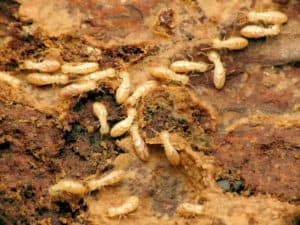
Subterranean termites are dreaded species since they do most of their damage undetected. They gradually locate and follow even the tiniest gaps in the floor slap and make their way upward.
In most cases, you will find that they follow the vertical strips that are laid on the walls. This is their possible route from the floor to the ceiling.
Once they are done destroying the baseboard, they follow the furring strips to the wooden trusses on the roof and begin to munch on them.
Termites can also trace the penetrations that are created when fixing plumbing pipes, electric circuits, and air conditioning refrigerant lines.
They follow these penetrations to the wooden parts of the house. Even if they find small cracks on the slabs that develop as they harden and settle, termites can still use them to penetrate the house.
Drywood termites
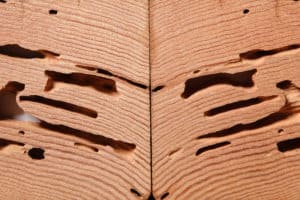
For Drywood termites, however, their criterion of getting into the building is much unique. During the swarming season, which usually takes place in spring, a winged termite enters the house from the roof.
It can be through penetrations created when fitting vents for chimneys or any other opening on and around the roof.
They take a longer period to establish colonies as compared to subterranean. Also, they are not as ferocious as subterranean termites but are very hard to detect.
They do not leave mud traces as subterranean do. This means they can create massive damage without getting noticed. Concrete block houses are less vulnerable to termite invasion but are not immune.
Can I Tent My Manufactured Home If I Notice Termite’s Invasion?
Well, this may not always be the case. Tenting your house will only be recommended for Drywood termites. It helps prevent them from getting into your manufactured home through the roof.
Otherwise, if WDO (Wood Destroying Organism) report indicates a subterranean termite’s invasion, it won’t be necessary to tent your home. Experts will recommend other treatments or prevention measures for you.
If you notice shed wings, small oval fecal pellets, and hallowed wood, it will tell your manufactured home is under Drywood termite invasion.
Tenting might become the option here. This, however, may not be the case if the infestation has only affected one area.
Chemical treatment on the affected area alone can be administered to destroy the termites.
Better, still, the affected wood can be removed and replaced.
Treating the area with chemicals before doing the replacement is highly recommended to kill all the remaining termites.
If Drywood termites have affected multiple areas of your home, tenting it will be appropriate. It is the absolute way to ensure that all termites are completely exterminated from your home.
Two Ways Of Handling Termites Infestation
1. Tenting Process
- A sealed volume of air is created by covering the structure completely using tarp panels.
- A fumigant spray is then pumped in.
- The most common brands for this purpose are Zythor, Master Fume, and Vikane. Sulfuryl fluoride is the active ingredient used for all these fumigants
- The fumigant gas eliminates, virtually, anything that is alive in the tented area. These could be small lizards, ants, and cockroaches.
Some people use heat to eliminate Drywood Termites from the wall frame.
It is yet another cool choice.
For this case, you will have to tent and heat the interior of the room to a temperature of about 140˚F.
It will produce a temperature of about 125˚F in the wood to ensure that all termites including their eggs are destroyed.
2. Using Chemicals
This is usually the case for subterranean Termites.
Perimeter chemical barrier is the smartest way to handle these destructive organisms.
The chemicals can either be placed in the areas surrounding the manufactured home and especially where the termites have been identified.
Better still; the chemicals can be pumped into the concrete blocks. When doing this, target the foundations of the structure. You can drill holes.
Experts have also devised another way of using baited systems.
In-ground canisters that contain poisoned wood are installed in the perimeter of the home.
This is a preventive measure against termite attack.
Why You Need A WDO Inspection
When buying or building a home, it is important to take a WDO inspection.
There are two primary reasons for taking this action.
- The first and most important reason is to check on the termite’s invasion.
- Second, it might be the policy of the real estate existing in the area to take a WDO inspection.
If your primary concern for taking a WDO inspection is to ensure your manufactured home is termite-free, we have outlined some facts to put under consideration before making that decision.
Make sure the home is treated with chemicals that kill all termites that might be invading or already present in the room.
If you have bought the structure, the treatment should be done if 8 years have elapsed since the last treatment. A new home, however, is less likely to be invaded by subterranean termites.
Related: How Can You Keep Animals from Digging Underneath a Manufactured Home?
Check if the property is under a termite warrant issued by a pest control company.
If you opt to use that same company to carry out a WDO report for you, it would be a noble idea. This is usually a cheaper route. Also, note that such warrants may not include wood rots or Drywood termites.
A termite WDO should be among the top priorities when choosing or setting up a new home.
Such an inspection is equally sensible as other key factors and you need to give it proper attention. This is especially true if your new home is a property acquired from someone else or another firm.
Final Thoughts
- All homes are vulnerable to termite attacks.
- While concrete buildings are less vulnerable, they are not immune.
- The surest way to keep track of potential termite infestation is hiring a firm to carry out a WDO report.
- Responding appropriately to termite attack is a sure way to safeguard your manufactured home.
- Termites can do massive destruction if not terminated early enough.

